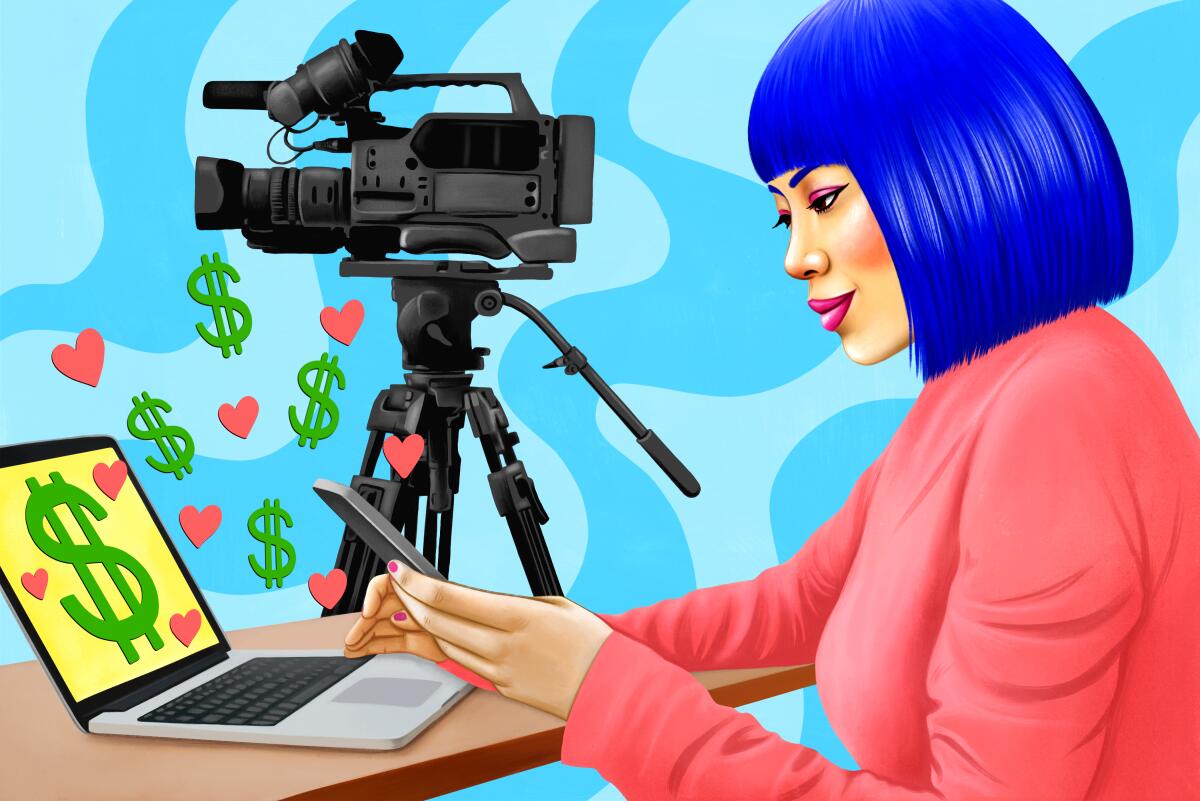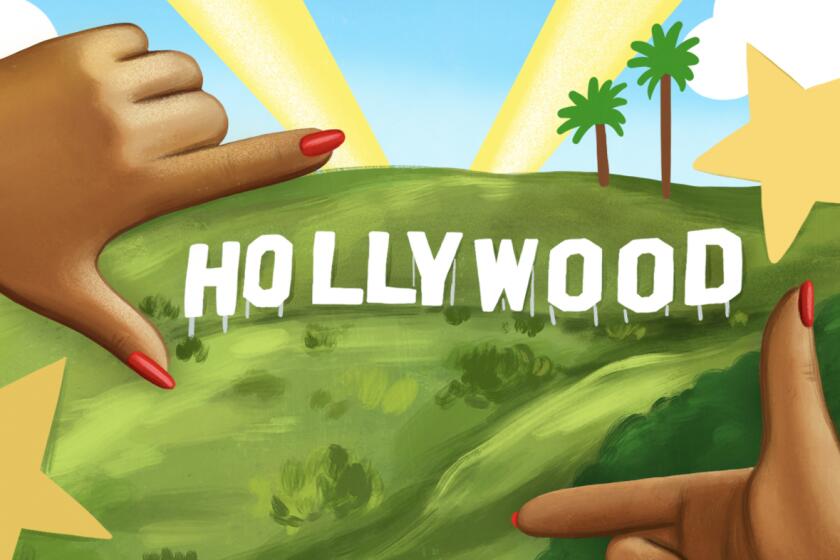Directing a short film is expensive. How to crowdfund it

- Share via
Writer William Yu always knew he wanted to try directing, but he thought he wouldn’t get the opportunity for years.
Directing even a short film can cost a lot of money. An average short costs between $700 to $1,500 per minute, according to several online estimates. You have to hire a cast and crew, rent equipment and secure locations, then pay for postproduction, promotion and distribution.
After his pilot script for “Good Boy,” which follows a Korean American aspiring streetwear designer, was selected for the 2020 Sundance Episodic Makers Lab, Yu started asking director friends whether he should try directing it himself.
“Everyone was really cautious about the advice they gave because it’s really hard,” he said. “You’re signing up for a long journey, and in many cases, it’s a sunk cost. You’re really doing it just because you have to do it.”
Yu said he’s not the type to take large risks, especially when it comes to money. Once he decided to take on the project as a director, he started a spreadsheet, listing every person he thought he could ask privately for money and a projected amount they might give. He calculated how much more he’d need in order to cover the rest of his budget.
The spreadsheet became a key tool in the crowdfunding campaign he launched last September that raised $17,768, which was enough to film his pilot. He’s currently submitting it to film festivals and shopping it to production companies.
Yu raised money through Seed&Spark, one of a number of crowdfunding sites that can help people raise money online for a wide range of projects, be they commercial, charitable or personal. Other sites include Kickstarter, Indiegogo and Patreon. There’s also Slated and Wefunder, which can match filmmakers with people looking to make equity investments in new projects.
Mounting a crowdfunding campaign requires a lot of time and effort, but there are potential gains that go beyond money. “We always say that crowdfunding done right is audience building first and fundraising second,” said Bri Castellini, the film community manager for Seed&Spark.
To get some advice on how to start, The Times talked to Yu and Castellini; Kayla Robinson, who successfully crowdfunded her short film “Ball Is Ball” in October; Jim Cummings, filmmaker (“Thunder Road,” “The Beta Test”) and founder of FilmFreeway’s The Short to Feature Lab; Will Haines, Indiegogo’s vice president of product and customer trust; and Ryan T. Husk, producer and campaign manager of The Star Trek Voyager Documentary, the most funded documentary on Indiegogo. Here are their insights.
For many people who pursue entertainment as a career, it takes years to get yourself to where you are making money from your creative work. For making money in the meantime, there’s always waiting tables. But more and more people are turning to platforms like TikTok, Twitch and Patreon.
To crowdfund or not to crowdfund
As a producer, Husk thinks of crowdfunding as a last resort. It’s way more work than paying for a project out of your own pocket (if you can afford to do that) or with the help of a few investors.
That said, he has worked on approximately 30 crowdfunding projects in the last decade, and “it’s great that we have last resorts, because back in the day, if nobody picks it up, it’s over,” he said.
Others say that if you need money, you should crowdfund — as simple as that.
“If you could shake the money tree of Hollywood and get financing to make short films, that’s great and good for you,” said Cummings. “I’ve never had success doing that, and none of my friends have had success.”
Castellini said even the lowest-budget films can benefit from some support. Plenty of crowdfunding campaigns aren’t seeking to cover the entire budget of a project, she said.
Cummings’ Kickstarter campaign to expand his short “Thunder Road” into a feature film covered the film’s preproduction costs.
Robinson ran her Seed&Spark campaign after she had already shot the film, and her goal was to raise the money to pay her cast and crew, who had volunteered their time because they believed in the project. Any money she made over her initial goal would go toward the rest of the cost of production, postproduction, festival showings and panel discussions.
“These kinds of smaller, more contained projects often do better because people want to contribute to something where they feel more confident that they’re going to get to the end and see the result,” Haines said.
Castellini encourages filmmakers to think of crowdfunding as the beginning of your marketing campaign.
“Ultimately, when you crowdfund, you are making the statement to the world: ‘I am making a movie, and I think you’re really going to dig it,’” she said. “At whatever point in that process it feels relevant to make that announcement, that’s when you should be crowdfunding.”
Directing TV is more competitive than ever with the wealth of high-quality storytelling in television and streaming. How do you break in? Here’s what you need to know.
Pick a crowdfunding site that fits your needs
Cummings suggested looking at other campaigns that successfully launched films that are similar to yours.
Kickstarter is the most popular crowdfunding site, but it’s an all-or-nothing platform — if you don’t meet or exceed the fundraising goal you set at the start of your campaign, the site won’t collect any of the money your backers pledged. Other platforms, including Indiegogo, offer more flexible funding.
“In reality, if you’re an independent filmmaker, you’re probably scrappy,” said Haines. “And while you may have this target, you may still be able to get it done with a lower target.”
Yu said that one of the reasons he chose Seed&Spark, which has both fixed and flexible funding options, is because the platform provides individual feedback on each campaign before it’s launched. “It feels like there’s a community on your side that is trying to give you the best chance to raise the money,” he said.
Other platforms also give people who can’t afford to support projects with money the opportunity to help in other ways — for example, supporters can “like” a project on Seed&Spark to help unlock discounts on gear for the filmmaker, or they can offer to let the filmmaker use their property for free.
Finally, if you’re trying to fund multiple projects, Patreon could be an option. The site allows users to donate a set amount of money every month, which could work well for filmmakers who are planning to make a series of short films.
Film producers will tell you that there’s no typical day in the job -- and there’s no single path to becoming a producer. But there are traits you can develop and entertainment industry paths to follow that will set you up for a career in Hollywood.
Preparation is key
Launching a crowdfunding campaign won’t miraculously cause strangers to drop their money into your hat, however. “What a lot of people who aren’t seasoned veteran crowdfunders don’t necessarily realize is that it’s not an ‘If you build it, they will come’ situation,” said Haines.
As Seed&Spark’s film community manager, Castellini gives feedback and guidance on how to run a successful crowdfunding campaign. She tells filmmakers they should be doing preproduction for a crowdfunding campaign the same way they would do preproduction for a film shoot.
A music supervisor combines the skills of a disc jockey and a negotiator to help pull together the soundtrack of a film or TV show.
Build an audience in advance
Haines said you’ll want to figure out which communities you need to reach out to, depending on who you are and what your project is about. He identified three primary groups of backers: those who really want to see the finished work, those who are really interested in the work’s cultural or societal impact, and those who want to support the person creating it.
A good illustration of this comes from Robinson, whose “Ball Is Ball” is a coming-of-age film about a high school basketball star navigating the “complicated nuances and lasting impact of sexual assault.” It’s inspired by her own life experience.
Because she had already shot the film, she was able to start her pitch video with clips that showed backers what they’d be paying for. When thinking about those who would be interested in the impact of the film, she knew it’d appeal to a number of groups, including sexual assault survivors and anyone passionate about the #MeToo movement; people who were interested in women’s athletics; and those who were interested in elevating Black and women filmmakers in Hollywood. And because she works as an art director at Apple, she had a network of Bay Area filmmakers who’d worked on one another’s projects over the years who would support her.
Yu made some similar calculations on his side. He has a screenwriting community that he knew would be supportive. Streetwear brands and sneaker shops rallied behind him. And he had built a Twitter audience of over 32,000 followers after starting the viral hashtag #StarringJohnCho, which advocates for more Asian Americans in leading roles.
”One great thing about especially the creative communities is that it’s not like business, where it’s all super, super competitive,” said Haines. “People want to support each other, so finding communities and cross-promotions can be a great way to bootstrap your success.”
For those who don’t already have a platform, Husk advises creating a way for like-minded people to follow you — whether it’s a social media account, a YouTube page or an email newsletter. That way, once you launch your campaign, you’re not spamming random people; you’re sending it to people who have already opted into learning more about what you’re working on.
“I’m a big proponent of promoting way ahead of time,” he said. “If you have six months, start promoting six months in advance. If you have two months, start promoting two months in advance.”
You’ve seen TikTok, Instagram and YouTube launch people into Hollywood stardom. Here are some tips for getting started as a social media influencer or creator.
Have an outreach plan
Castellini points to a stat she often shares in her workshops: A direct email has a 20% to 30% chance of convincing someone to support a project, whereas a tweet succeeds less than 10% of the time.
But direct contacts take time and effort, so if you will be reaching out to individuals one by one, you’ll need to pace yourself, said Robinson. It also helps to create a database of potential backers. “I had a whole Excel spreadsheet that had all the names and emails of people I planned to reach out to each day,” she said. She also kept track of everyone who was engaging with her social media feeds and reached out directly to them.
Yu also recommends spreadsheets. “Even with all that work, it’s still stressful,” he said. “But you can at least say, ‘Hey, I’ve got 50 people here that I know that I’ve talked to in the last year who like film and care about Asian American stuff. Let me concentrate my effort there.’ And that’s not only time saved but also emotional energy you don’t have to spend on other people.”
Instead of approaching backers one at a time, some crowdfunders come up with a digital marketing strategy. When Cummings advises filmmakers who come to FilmFreeway’s Short to Feature Lab, he recommends learning how to use Facebook Ads Manager in order to target the right people — fans, advocates, filmmakers, journalists, people into crowdfunding.
“You can spend 20 bucks on it and get 250 people who otherwise wouldn’t have seen your movie to see it,” he said.
Data show that the younger generation of viewers spends half of its waking hours on screen time. That’s good news and bad news.
Figure out how to be in-your-face without being annoying
Though social media posts are much less effective in attracting backers, they’re still an important part of your strategy. They’ll expose you to people you wouldn’t have reached with direct emails, and you need every supporter you can find.
“You have to be very, you know, politely in people’s faces about it,” Yu said.
It’s a tricky balance, and Husk said the reason it’s hard to tread that line is because the line is different for each person. “You posting once can annoy some people,” he said. “You posting 20 times might not annoy other people.”
So it boils down to finding the folks who will see your pitch as an opportunity, not as a guilt trip.
“If I’m doing a ‘Star Trek’ documentary, and I post it in ‘Star Trek’ groups,’ they’re not going to say, ‘Oh, this is annoying.’ They’re going to say, ‘Whoa, cool, a new “Star Trek” documentary? Where do I sign up?’”
Yu said one of the tips he got from his Seed&Spark mentor was that for every post you make about your project, you should be posting five times about other things.
“You want it to feel organic,” he said. “So, if my project is about streetwear, I can also tweet about the new sneakers that just came out. ... Or, since my project is about Korean Americans, I can share another Korean American story that I think is really interesting.”
Launch strategically
Husk said that the first day is by far the most important day of your campaign.
Haines agreed. “People sometimes feel shy about doing this, but if it were me, and I had a $10,000 goal for my film, I would literally have a list of people that I’ve already reached out to who I know are going to donate, and when it launches, you reach out to those people, and now you suddenly have $3,000 raised.”
Once you start to show traction, you’re much more likely to get contributions from people who are outside your network, he said.
“Even if it’s the coolest idea in the world, if people see that it has $0, they hesitate,” he said.
He explained that the Indiegogo algorithm decides which campaigns to display more prominently on the site based on how much response they’ve gotten from the public. If you can generate some momentum, it’s more likely that your campaign will get featured in the site’s film category or its newsletter and that it will appear more prominently in Indiegogo search results.
“Crowdfunding helps people who help themselves,” he said. “You have to give yourself the first push. Almost everyone has someone who wants to donate. Like, your mom probably wants to put some money into it. So let’s do that strategically.”
It’s also helpful to know that the most popular contribution times are the first week and the last three days of the campaign, Castellini said.
“And the harder time you have maintaining the momentum between those two periods, the less those last three days are going to help you,” she said.
She recommends offering short-term incentives in the middle weeks. “Something where there’s only like 15 available and you release that in week two,” she said. “Or, ‘Limited time, first come, first serve.’”
Send the L.A. Times your questions about breaking into and working in the entertainment industry.
Other good advice
Tell your personal story in your pitch video. Some people use a teaser as their pitch video, but it’s better to have the human story behind the film, said Haines. “There are a lot of people who actually want to be along for the journey,” he said. “If you can tell that story, that can be really, really powerful.”
Run a 30-day campaign. There are often options to do campaigns that are longer than 30 days, but Haines said the 30-day campaigns generally tend to find more success because there is more urgency. “Just spend those 30 days really focusing,” he said.
Limit the physical rewards; keep it digital if possible. “We ran physical rewards for most of our early campaigns, and I spent most of my life in the post office sending out posters,” said Cummings. “It was really, really exhausting.”
If you do have physical rewards, make sure you take into consideration the cost to design, print, package and ship them, Castellini said. Her first campaign offered a signed poster as a reward. “We were losing money on every single contribution at that level,” she said.
Don’t ask for too much money. Husk advises putting your goal not at your ideal amount, but at the bare-bones minimum to make the film. “This is totally counterintuitive,” he acknowledged. “But if you dangle a carrot way out there, people are going to say, ‘That’s too far. It’ll never happen. I’m not going to waste my money.’ Or they’ll say, ‘Huh, I’ll come back when they get closer and see how it’s doing.’ They’re not going to be encouraged to donate.
“But if you’re asking for something that’s just right over the horizon, just so attainable, then everybody will be motivated. And then you can add stretch goals.”
Rejection and uncertainty are part of working in Hollywood, but joy, creativity and fun can be too. Here’s how to manage your mental health.
Tag-team your campaign. No one will care about your project more than you will, and often crowdfunding is a one-person operation. But if you can find a partner to help, it could pay off handsomely. Haines said that campaigns that have more than one person running them tend to raise more than twice as much. “I think that’s because maybe you’re the creative genius, and you’re great at the content piece,” he said. “Find someone who’s good at the other piece.”
Think of crowdfunding as getting people as excited about the project as you are. When you find the right audience for your work, “then it’s not the awkward, ‘Hey, it’s me asking for money again,’” said Castellini, who is also the co-host of the podcast “Breaking Out of Breaking In” and a filmmaker who has crowdfunded her own projects. “I’ve had people who were contributing to my campaigns on a tiny scale early on, who now have doubled or tripled their initial contribution to my latest campaign, simply because they trust me. And that trust is because I included them in the process, rather than treating them as, you know, a piggy bank that I’ll shake every couple of years.”
About The Times Utility Journalism Team
This article is from The Times’ Utility Journalism Team. Our mission is to be essential to the lives of Southern Californians by publishing information that solves problems, answers questions and helps with decision making. We serve audiences in and around Los Angeles — including current Times subscribers and diverse communities that haven’t historically had their needs met by our coverage.
How can we be useful to you and your community? Email utility (at) latimes.com or one of our journalists: Jon Healey, Ada Tseng, Jessica Roy and Karen Garcia.
More to Read
Inside the business of entertainment
The Wide Shot brings you news, analysis and insights on everything from streaming wars to production — and what it all means for the future.
You may occasionally receive promotional content from the Los Angeles Times.



















